 When Beilstein Commander starts up, you will be confronted by a login-prompt for your ATHENS account (i.e of the type iclXXXX).
On a Macintosh computer, Beilstein Commander will start, and a predefined query will appear in the windows. On a windows
computer, due to a system error, no predefined queries appear, and you will have to enter them by hand.
When Beilstein Commander starts up, you will be confronted by a login-prompt for your ATHENS account (i.e of the type iclXXXX).
On a Macintosh computer, Beilstein Commander will start, and a predefined query will appear in the windows. On a windows
computer, due to a system error, no predefined queries appear, and you will have to enter them by hand.
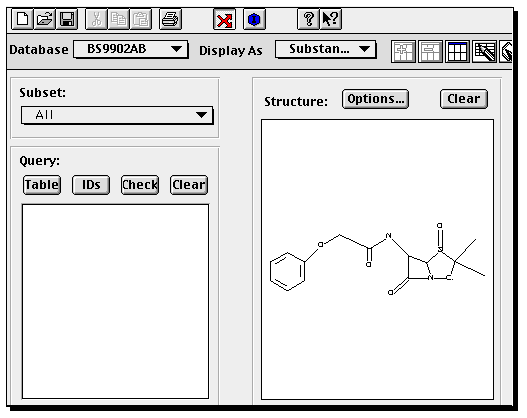 Chekc at this stage whether the defined database is e.g. BS9902AB (it might also be Gmelin, which you dont want
to search for penicillins).
If you wish to edit or modify this structure, double click on the molecule, whereupon
a structure editor window will open. This can be either a built in editor, the screens for which are shown below,
or it can be set to ISIS/Draw, which is a separate program (Unfortunately, ChemDraw is not an option).
The selection can be made from the Options/Structure and Fact Editors
menu item in Commander.
Chekc at this stage whether the defined database is e.g. BS9902AB (it might also be Gmelin, which you dont want
to search for penicillins).
If you wish to edit or modify this structure, double click on the molecule, whereupon
a structure editor window will open. This can be either a built in editor, the screens for which are shown below,
or it can be set to ISIS/Draw, which is a separate program (Unfortunately, ChemDraw is not an option).
The selection can be made from the Options/Structure and Fact Editors
menu item in Commander.
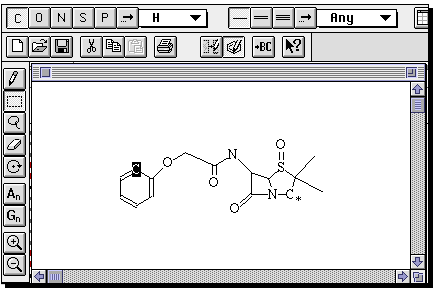 The important thing about this structure, is that missing valencies are assumed
to be hydrogen rather than generic substituents. To allow a search to proceed
on the assumption that any substituent can occupy a free site, go to the capture tool
(the dotted square icon), then highlight an atom (or several, by dragging the capture
box) and from the Query menu, select "Free Sites". This places a star against the atom(s).
If you do not do this, you may not find any structures. Other editing operations are
(sort of) intuitive, and it is suggested you explore them. Once happy with the structure,
click on the "BC" button along the top to return to Commander. If you are using ISIS/Draw as your structure editor,
return to Commander by clicking on the button;
The important thing about this structure, is that missing valencies are assumed
to be hydrogen rather than generic substituents. To allow a search to proceed
on the assumption that any substituent can occupy a free site, go to the capture tool
(the dotted square icon), then highlight an atom (or several, by dragging the capture
box) and from the Query menu, select "Free Sites". This places a star against the atom(s).
If you do not do this, you may not find any structures. Other editing operations are
(sort of) intuitive, and it is suggested you explore them. Once happy with the structure,
click on the "BC" button along the top to return to Commander. If you are using ISIS/Draw as your structure editor,
return to Commander by clicking on the button;
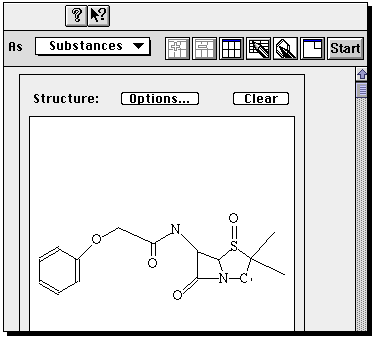 Now click on Start to
commence the search.
You will be told how many hits are found (for an unmodified structure
query it should be between 100-200!). A new program called Display Hits starts up
From menu View, select Short display to
get a preview of structures found.
Now click on Start to
commence the search.
You will be told how many hits are found (for an unmodified structure
query it should be between 100-200!). A new program called Display Hits starts up
From menu View, select Short display to
get a preview of structures found.
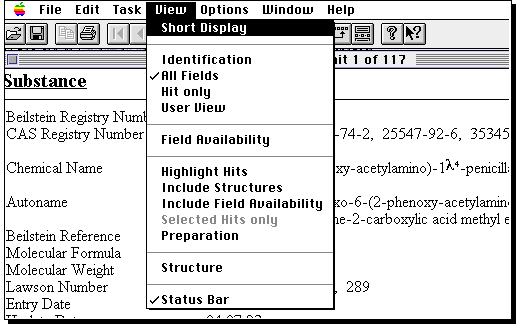 You can select individual entries by clicking on them.
Go back to full display to obtain data such as optical rotation or melting point.
You can select individual entries by clicking on them.
Go back to full display to obtain data such as optical rotation or melting point.
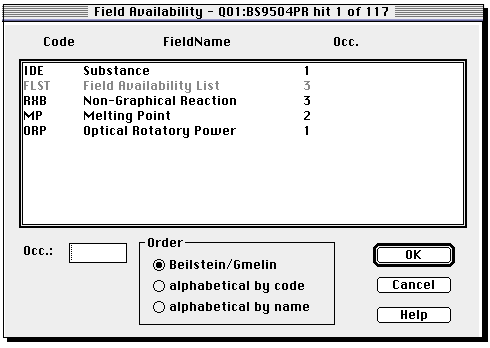
![[BACK]](BackBtn.gif) ------------- Page 7 of 9 -------------
------------- Page 7 of 9 -------------
![[NEXT]](NextBtn.gif)
©H. S. Rzepa and ICSTM Chemistry Department, 1994-2000.








![[BACK]](BackBtn.gif) ------------- Page 7 of 9 -------------
------------- Page 7 of 9 -------------
![[NEXT]](NextBtn.gif)